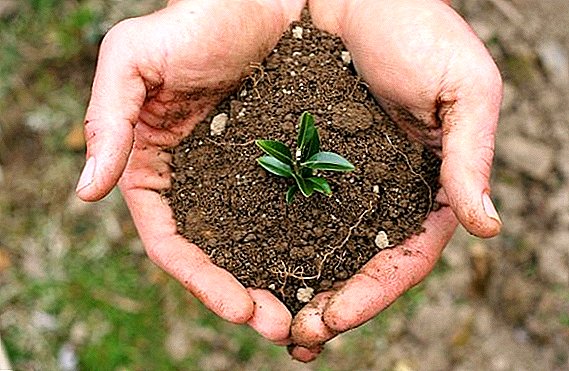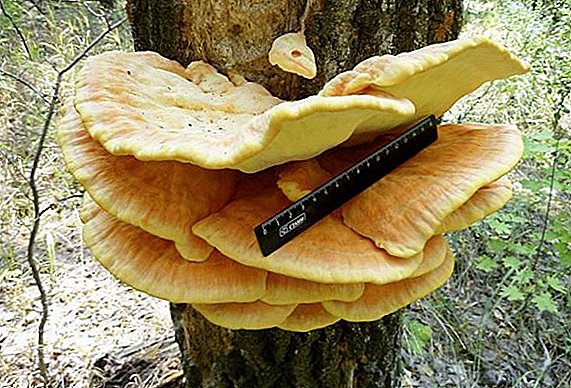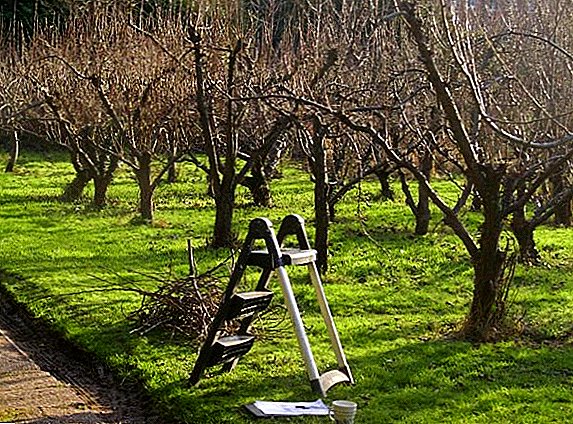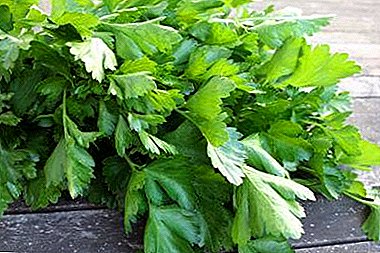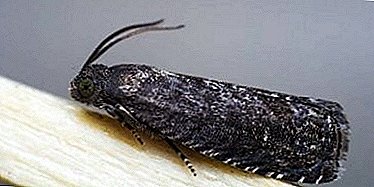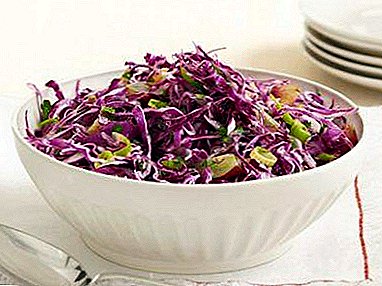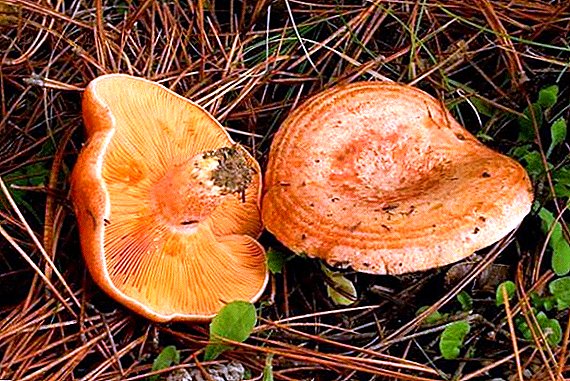 Ryzhiki are one of the most common mushrooms in temperate latitudes - they not only have excellent taste characteristics, but also have useful properties. Where they grow, what types there are, how to collect and harvest mushrooms, let's consider in more detail.
Ryzhiki are one of the most common mushrooms in temperate latitudes - they not only have excellent taste characteristics, but also have useful properties. Where they grow, what types there are, how to collect and harvest mushrooms, let's consider in more detail.
Most common types
Ryzhiki are among the representatives of the genus Mlechnik, which includes about 7 names of the subspecies - red, salmon, alpine and others. In this case, it is believed that the main varieties of the present camelina are pine and spruce species.
Check out the list of edible and poisonous mushrooms, as well as learn how to check the mushrooms for edibility by folk methods.
Present
The ripening time of this camelina falls in the middle of June, and it can be found in the forest before the onset of cooling (until mid-September). It belongs to the category I edibility of the mushroom (absolutely edible and nutritious mushrooms). It has the following external characteristics:

- a hat - characteristic bright orange color, shiny, large size (up to 14 cm in diameter). On the surface of the cap are encircling rings, sometimes whitish plaque. The form has a standard - convex, spherical. A small depression may form in the middle of the cap, and the edges will wrap inward (especially for large mushrooms). The surface is smooth, slightly slippery and sticky.
- leg - thick, large (up to 10 cm in height). The color always corresponds to the basic shade of the cap. The foot is rough with small shcherbinka or pits. Can be covered with a small gun. To the top tapers slightly, forming a disproportionate cylinder.
- records - thin, forked, densely dotting the bottom of the cap. Often the plates come into the base of the leg of the fungus (occupying no more than one third of the entire length of the leg). The color is orange, with a brownish tint, but when you press the plate get a green tint.
- the pulp - dense texture, saturated orange color. In the open air it may become green.
- the juice - thick and plentiful, sweet to the taste.
Did you know? Ryzhiki - the only representatives of mushrooms in the world that have yellow milk juice.
Spruce
This variety of camelina got its name because of its territorial formation - fir mushrooms only grow near the roots of spruce or on the spruce litter. It is an edible mushroom. External data:

- a hat - up to 7 cm in diameter, has a mandatory knob in the center. The edges are fragile, curved to the bottom. The older the eloviki, the more their cap takes on a curvilous funnel shape. Peel without roughness. When wet air becomes sticky to the touch. The color varies from orange to brown, the rings and concentric spots on the cap are always darker than the base color. If you damage the delicate skin of the cap, it will get a green tint;
- leg - up to 6 cm in height, thin (up to 1 cm in diameter), very fragile and fragile. The cylindrical shape to the base narrows slightly. The color is the same as the cap;
- records - abundant, frequent, descend at the base of the leg. Have a lighter shade in comparison with the cap;
- the pulp - orange, at the breaks it is first painted in a red tint, and then becomes greenish. It has a sweet-fruity flavor;
- the juice - thick, red tint. In the open air becomes greenish.
Important! Despite the fact that camelina can be eaten raw, you should not risk it and eat it without heat treatment - in nature, poisonous and edible mushrooms often grow together, touch each other, and poisonous spores can turn into an edible fungus.
Elovik grows from the beginning of the summer until the middle of autumn (until the end of October, provided there is no frost).
Red
The least common species of camelina, which grows only in coniferous bedding in the highland areas. Specifications:

- a hat - flat, large size (up to 16 cm in diameter), sometimes squeezed in the center. Very dense texture, fleshy. In young specimens, the edges are folded inward; in adults, the cap practically does not bend. The color is orange-red, shiny, does not lose elasticity and does not become slippery when wet;
- leg - relatively short, up to 6 cm in height. Very dense and strong, with a big mealy patina and red hollows.
- records - frequent, narrow, strongly descend along the leg;
- the pulp - very dense, but fragile, white shade with bright dark-red chaotic spots. At the breaks from the pulp flowed milky juice of bright red color.
Unlike other subspecies of camelina, such a red mushroom has no concentric spots and circles on the cap. Distinguishes it from other representatives of the subspecies presence of thick juice of bloody hue.
Did you know? A strong antibiotic lactarioviolin, which successfully fights against pathogenic bacteria, and in particular, with Koch sticks, is derived from redfish.
False
Bright external data of mushrooms and their dissimilarity to other mushrooms will not allow to confuse this species with poisonous or inedible mushrooms. However, among the varieties of mushrooms there are such representatives that are not fully edible mushrooms. They belong to class IV - conditionally edible mushrooms). These are the doubles of camelina - pink waves, a papillary and a milky scent fragrant.
- Pink waves. It has white milk juice, which does not darken when in contact with air. Grows mainly in deciduous thickets, near birch or aspen. In contrast to this camelina has a pink color of the pulp, and the leg - a small and thin. The pink wave is not poisonous, however, with insufficient heat treatment, it causes serious problems with the stomach and intestines.
- Papillary breast (large crab). It grows in coniferous forests, is a conditionally edible mushroom. The cap is gray-brown, of small diameter, the milky juice is always white. The flesh is also white in color, with a slight coconut flavor. It is possible to eat only after careful soaking and long-term salting.
- Mlechnik fragrant. It has a small cap with a diameter of up to 5 cm brown. The edges are always concave inward, slightly torn along the contour. The smell is very strong, spicy, resembles a coconut. In cooking, it is used only in dried or salted form as a spice to other dishes.



Locations and collection season
Ryzhiki always grow in small groups - most often found in mixed and coniferous forests, as well as between the roots of trees and in moss. They do not like the cold, so they form and ripen in the warm months - from the beginning of summer to mid-autumn. The most mass ripening period is July-beginning of September. Distributed in almost all continents, but most often found in the temperate climate zone.
Read also about the beneficial properties and application in various branches of mushrooms: morels, flakes, cheeses, reishi mushrooms, white trucks, pigs, boletus, chanterelles, boletus mushrooms, boletus, champignons, mushrooms, butter, white mushrooms, shiitake, chagi (birch mushroom) .
What is the difference between mushrooms and the wind
The external similarity of these two species of mushrooms is very large, but there are some significant differences. The first - This is a characteristic of the milky juice. In volnushka it is always white, and in Ryzhikov - yellow or orange, which acquires a greenish tint in the open air.
 Milky sap of fungus
Milky sap of fungus  Milky juice mushroom redhead
Milky juice mushroom redhead
If you turn both of these mushrooms and look under the cap, then you can distinguish them very easily: the waves of the plate are always pale pink or gray, but the mushrooms are fully justify their name - their plates are red, orange or bright yellow. The next way to distinguish these twins is their place of growth.
 Wafer mushroom plate
Wafer mushroom plate  Fungus mushroom plate
Fungus mushroom plate
Volnushka prefers to grow near birch and some other deciduous trees, but mushrooms are most often formed on coniferous bedding and roots of pines and spruce. Ryzhik loves clean ecology and unpolluted air; therefore, it does not occur near highways, unlike windfalls - they are less sensitive to air parameters and grow massively on roadsides.
Chemical composition
The composition of this mushroom includes such components as: protein, water, ash, fiber, monosaccharides and disaccharides, minerals, vitamins of groups B, vitamin C and elements such as sodium, phosphorus, iron, magnesium, etc. Mass fraction of dietary fiber is 11%, vitamin B2 - 11.2%, potassium - 12.5%, iron - 15.5%. The ratio of BZHU is 1.9: 0.8: 0.6 (per 100 grams of product). The caloric content of 100 grams of the fungus is 17 kcal, however, during heat treatment (especially salting and frying), the caloric content increases significantly.

What is useful
Ginger is a very useful multivitamin mushroom - its active ingredients and provitamins have a strong antioxidant effect, strengthen the immune system and help reduce the risk of cholesterol blockage. In addition, the fungus contains a strong antibiotic that fights against active pathogenic viruses and bacteria (in particular, it neutralizes tuberculosis). It is these beneficial properties of camelina that determine its harmlessness - this mushroom can be eaten raw even without heat treatment.
Also, immunity is positively influenced by: safflower, horseradish, garlic, savory, apples, ramson, fir, black walnut, aloe, almonds, white sturgeon, viburnum, dogwood, magnolia vine, mint, basil, melissa.
In addition to useful properties, saffron milk is nutritious and has excellent taste. - its oily pulp is not inferior in taste indicators to the most tasty kind - white mushroom. In terms of its energy component, this mushroom approaches beef and turkey, and in terms of calories it exceeds poultry meat and chicken eggs.

Contraindications and harm
This nourishing fungus must be carefully consumed by people with digestive problems and also prone to obesity. It is not recommended to eat mushrooms with kidney and liver diseases (especially in the chronic stage), pregnant women and children under 6 years old. Also contraindications are tumors and stomach ulcers, inflammation of the pancreas, low acidity of the stomach.
Important! Pregnant and lactating mothers should limit the consumption of saffron milk - it can significantly reduce the acidity of the stomach and lead to problems with the digestive tract.
Cooking recipes
Scented and fragrant saffron steadfastly entered the culinary sphere - it is used both in raw form and as a seasoning, as well as an independent dish.
Pickling
This mushroom is the best suited for salting - its fruit flavor interacts with salty brine, forming a unique spicy taste.

Ingredients:
- 0.5 kg. mushrooms;
- 25 gr. salts;
- 0.5 teaspoons of allspice and peppercorns;
- Bay leaf;
- horseradish leaves.
Read just as quickly and tasty salted mushrooms for the winter
Cooking method:
- Prepare mushrooms for pickling - sort, wash, remove contaminated places, cut off the ground from the leg.
- Coarsely chop the mushrooms (small, you can simply cut in half), pour hot water and let stand 5 minutes.
- Mushrooms flooded with water are set on a fire, brought to a boil and kept on fire for another 7 minutes. The formed foam is removed with a skimmer.
- Drain the water, we shift the mushrooms brought to half-ready into the saucepan, pour in salt and spices. Cover with horseradish leaves, put a clean cloth on top (you can wear gauze) and press down with a heavy load.
- We put the blank pressed in such a way in a cold place (the temperature should not exceed 7 ° С). Stored this way for 45 days. Periodically you need to check the brine - if it turned black, you need to wash the mushrooms and fill them with fresh spices. Fabric periodically (1 time in 2 weeks) should also be replaced with a clean one.





Video: how to pickle mushrooms
Pickled
Marinated mushrooms are considered the best snack and a real table decoration in the winter months.
Ingredients:
- 1 kg. mushrooms;
- 2.5 tsp salts;
- Bay leaf;
- 1 onion;
- 2-3 cloves of garlic;
- 3 tsp. Sahara;
- a glass of vinegar 9%;
- water (600-700 ml).

Cooking method:
- Mushrooms to sort and wash, remove contaminated places and pieces of earth. Fill with clean cold water and let it boil.
- Add salt to boiling water, cook for 10-15 minutes. After that, drain the water.
- Place a bay leaf, spices, garlic in a clean jar, put boiled mushrooms in the jar.
- Cook the marinade - mix 3 tsp. salt and 3 tsp. sugar, vinegar and water, cook over low heat for 10 minutes.
- Remove the marinade from the heat, add the finely chopped onion.
- Pour the hot marinade mushrooms, tighten the jars and sterilize them for 30 minutes.
- Turn the jars, cool under a warm blanket. Return to its original position and place in a dark cool place (refrigerator or cellar).






Mushrooms prepared in this way are crispy and dense in texture.
We advise you to read about the technology of cooking mushrooms: pickling (chanterelles, wild mushrooms, milk mushrooms, ryadovki), pickling (dried mushrooms), drying (oyster mushrooms), freezing (white, oyster mushrooms, chanterelles, mushrooms, champignons).
Video: marinated mushrooms for the winter.
Fried
To prepare a nutritious dish of fried mushrooms does not take much time and effort - even beginning cooks will be able to cope with this treat.
The most common ingredient for fried mushrooms is onions. For the preparation of mushrooms with onions you will need:
- mushrooms mushrooms;
- olive oil - 50 ml .;
- onions - 2-3 heads;
- salt, spices - to taste.
Cooking method:
- Bust, rinse and remove dirt from the mushrooms. Cut the mushrooms in small slices.
- Boil the mushrooms in salted water for 15 minutes.
- Let the water drain and put the mushrooms in a hot frying pan (without oil). Wait until the excess moisture evaporates.
- Add butter, chopped onion and spices. Fry over medium heat for 15-20 minutes.
- 3 minutes before the end of cooking, cover the pan with a lid and stir the mushrooms in its own juice for 2-3 minutes.
- Put on a dish, decorate with greens. Serve with sour cream.






Video: how to fry mushrooms
Ryzhiki are very tasty and healthy mushrooms that will not only saturate and provide the body with plenty of protein, but also strengthen the immune system, increase resistance to viral diseases. Knowledge of the rules of collection, harvesting and salting of this mushroom will help prepare nutritious, fragrant dishes that will occupy a worthy place both on a festive and everyday table.


